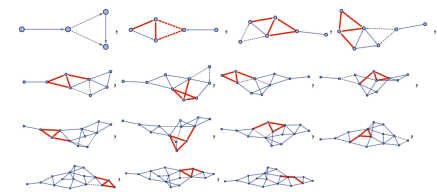Fundamental Physics: Difference between revisions
No edit summary |
No edit summary |
||
| Line 27: | Line 27: | ||
So how does this relate to time? What it says is that in the basic statement of the model there is not just one path of time; there are many paths, and many “histories”. But the model—and the rule that is used—determines all of them. And we have seen a hint of something else: that even if we might think we are following an “independent” path of history, it may actually merge with another path<ref name=":0" />. | So how does this relate to time? What it says is that in the basic statement of the model there is not just one path of time; there are many paths, and many “histories”. But the model—and the rule that is used—determines all of them. And we have seen a hint of something else: that even if we might think we are following an “independent” path of history, it may actually merge with another path<ref name=":0" />. | ||
Latest revision as of 04:15, 20 August 2025
Time
Time as a Computational Process
In traditional scientific accounts, time is often represented as some kind of coordinate much like space. While this may be a useful mathematical description, it does not say anything about what time in a sense “intrinsically is”. In the Wolfram Physics Project, time is thought of computationally, with successive states of the world being computed one from the last by the progressive application of some computational rule.
However, the phenomenon of Computational Irreducibility[1][2] does not allow the “time coordinate” to be simply replaced with a “computational step count”. With the traditional mathematical idea of a time coordinate one typically imagines that this coordinate can be “set to any value”, and that then one can immediately calculate the state of the system at that time. But computational irreducibility implies that it’s not that easy. Because it says that there’s often essentially no better way to find what a system will do than by explicitly tracing through each step in its evolution[2].
The Role of the Observer
That time is a reflection of the progress of computation in the universe is an important starting point. But it’s not the end of the story. For example, here’s an immediate issue. If we have a computational rule that determines each successive state of a system it’s at least in principle possible to know the whole future of the system. So given this why then do we have the experience of the future only “unfolding as it happens”?[2]
It’s fundamentally because of the way we are as observers. If the underlying system is computationally irreducible, then to work out its future behavior requires an irreducible amount of computational work. But it’s a core feature of observers like us that we are computationally bounded. So we can’t do all that irreducible computational work to “know the whole future”—and instead we’re effectively stuck just doing computation alongside the system itself, never able to substantially “jump ahead”, and only able to see the future “progressively unfold”[2].
Space
In the Wolfram Model of physics, space consists of discrete, abstract relations between abstract points. In the below figures we have a rule that’s just specifying how to rewrite pieces of an abstract hypergraph, with no notion of geometry, or anything about 3D space. And yet it produces a hypergraph that’s naturally laid out as something that looks like a 3D surface.[3]
-
A diagram showing the rule {{x, y, z}, {u, y, v}} → {{w, z, x}, {z, w, u}, {x, y, w}}
-
The state of the hypergraph after each application of the rule
-
The final state of the hypergraph after applying the rule many times

Multiway Systems
A rule may have multiple possible ways of applying it. For example, the rule {{x, y}, {x, z}} → {{x, z}, {x, w}, {y, w}, {z, w}} defines how to take take two connections in the hypergraph and transform them into four new connections. The rule just says to find two adjacent connections, and if there are several possible choices, it says nothing about which one. A crucial idea in the Wolfram Physics Project is in a sense just to do all of them.[3]

All possible paths a system can take is represented by the Multiway Graph.[4] For the very first update, there are two possibilities. Then for each of the results of these, there are four additional possibilities. But at the next update, something important happens: two of the branches merge. In other words, even though we have done a different sequence of updates, the outcome is the same.[3]
So how does this relate to time? What it says is that in the basic statement of the model there is not just one path of time; there are many paths, and many “histories”. But the model—and the rule that is used—determines all of them. And we have seen a hint of something else: that even if we might think we are following an “independent” path of history, it may actually merge with another path[3].
References
- ↑ Wolfram, Stephen (2002). A New Kind of Science. Wolfram Media. p. 237. ISBN 1-57955-008-8.
- ↑ 2.0 2.1 2.2 2.3 Wolfram, Stephen (8 October 2024). "On the Nature of Time". Stephen Wolfram Writings.
- ↑ 3.0 3.1 3.2 3.3 Wolfram, Stephen (14 April 2020). "Finally We May Have a Path to the Fundamental Theory of Physics… and It's Beautiful". Stephen Wolfram Writings.
- ↑ Wolfram, Stephen (2020). "A Class of Models with the Potential to Represent Fundamental Physics". Complex Systems. 29 (2). Multiway Systems for Our Models.


